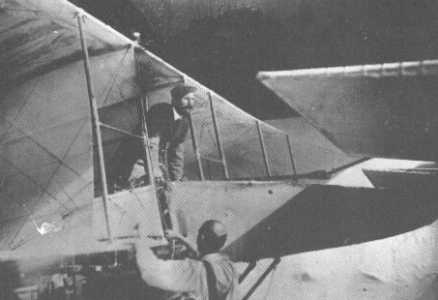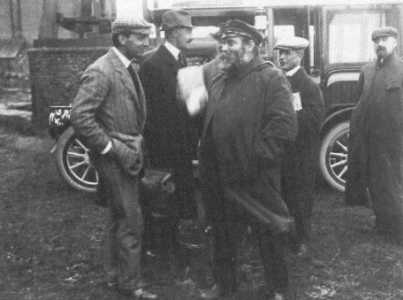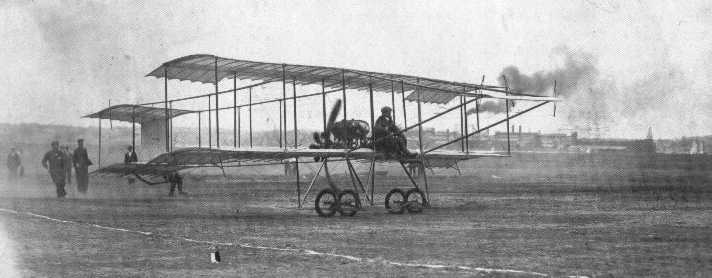|
Reims:
the first air race

Henri Farman (who died in 1958)
examining one of his planes in 1908. The
vertical flaps Farman used for structural
stability also provided aerial stability
in ways Farman did not understand.
Blériot's
cross-Channel flight excited Europe as nothing else had.
The City of Reims and the French vintners of the Champagne region
decided to sponsor a week of aviation exhibition and competition, putting
up large purses in prize money, the most prestigious being the
International Aviation Cup, known as the Gordon Bennett Trophy, after its
sponsor, James Gordon Bennett, the flamboyant American publisher of the
New York Herald and the Paris Herald.
The meet attracted the cream of European society, from royalty
and generals to ambassadors and the merely wealthy, to the Betheny Plain
outside Reims from August 22 to 29, 1909.
While there were to be many other such meets before and after World
War 1, none would match Reims for grandeur and elegance or for sheer
excitement.
The major
European manufacturers, all French, entered various events.
There were
'planes
by Bleriot,
Voisin, Antoinette, and Farman, and even several French-built
Wrights. The Wrights
themselves had passed on an invitation to race at Reims, which was awkward
since the Gordon Bennett Trophy was crowned with a large replica of a
Wright Flyer. The Aero Club
of America, which had sponsored the Scientific American trophy won
by Curtiss a year earlier, turned to Curtiss.
Curtiss' June Bug was not as well developed a plane
as the Wright machines (and possibly the Wrights were hoping to drive this
point home if Curtiss failed at Reims) and while it was more maneuverable
than the European planes, it was not nearly as fast.
Curtiss worked
feverishly to produce a more powerful engine and stripped down his
airplane to give it greater speed.
The result was the Golden Flyer, which was a light version
of his earlier planes and had a 50-horsepower water-cooled engine.
With virtually no time to test the engine or the airplane, Curtiss
packed and was off to Reims.
When he arrived, he found that the accommodations for the aviators set up
by their manufacturers were as extravagant as those of the spectators.
Elaborate cooking
facilities, decorated hangars, fully stocked machine shops, trunks
brimming with clothing, spare parts and backup planes, and a retinue of
mechanics and helpers, all floated on an ebullient sea of champagne
provided by the sponsors.
Curtiss' spartan approach was a simple tent, a single plane, and two
scruffily dressed mechanics. So surprised were the French that he
instantly became a favourite.

The designer-pilot team of Hubert
Latham (at left) and Leon Levavasseur confer at Reims in 1909.
A brief but heavy
rain on the first day turned the field into a muddy plain that was to
affect take-offs throughout the meet.
But there were so many aircraft, built by every major manufacturer
and flown by every famous aviator, that the crowd was kept enthralled for
the entire week. The early
winners included Farman, flying one of his own planes equipped with the
newly designed Gnome rotary engine, just beating Latham (flying an
Antoinette) and Louis Paulhan (flying a Voisin) for the endurance
championship; Latham, who won the altitude championship handily; and
Eugene Lefebvre, flying a Wright Model A, who had the best
qualifying round for the Gordon Bennett Trophy.
Curtiss, aware that he had only one plane and precious few
replacement parts, held back and worked on his aircraft in secret, trying
to lighten it and squeeze out more power from the engine.
He knew that his plane was not as fast on the straightaway as the
light, single-winged
Blériot XII, which was outfitted with a new
80-horsepower engine, but he had won many a motorcycle race on the turns
with inferior machines.
On the last day
of the meet, the race was held for the Gordon Bennett Trophy.
It came down to a contest among Lefebvre,
Latham,
Blériot, George Cockburn (a Scott flying a Farman plane), and
Curtiss, now flying a machine he called the Reims Racer, which was
in fact a further stripped-down model of the Golden Flyer.
The course consisted of two six-mile (10km) circuits around
tall towers, with each plane flying alone and timed.
Cockburn was the only entrant who failed to finish, his aircraft
crashing into a haystack after a single lap.
The others thrilled the crowd with their sharp turns and with the
drama of the race.
During tests, Curtiss
noticed that the field, drenched by the rains earlier in the week but now
drying, had pockets of updrafts that tossed his lighter plane violently.
He guessed (blindly, but correctly) that these updrafts would
increase the efficiency of his propellers and could help carry him forward
and keep him steady on the
turns.
He abruptly notified the judges that he was going to race (fearing
the updrafts would wane as the day grew hotter) and took off.
His flight was a bumpy one as he bobbed up and down trying to catch
the updrafts while keeping his plane under control and taking the sharp
turns. It was an extraordinary feat of piloting, because when he landed,
he had been timed at fifteen minutes and 50.4 seconds.
Lefebvre and Latham did not come close to that time, so French
hopes rested with
Blériot, who decided to pilot his own plane, replacing
Leon Delagrange, the lighter man who had flown
Blériot's planes throughout
the meet. Delagrange had not
flown well and had nearly had a mid-air collision with Paulhan the day
before.

The pusher (propeller in the rear) was the design of
choice
as long as the pilot was exposed to the wind.
Geoffrey de Havilland’s No. 2 was nimble, but slow
The powerful Blériot XII streaked straight across the sky and
completed the first lap ten seconds faster than Curtiss, who watched from
the sidelines, anticipating a second-place finish.
But Blériot took the turn clumsily and swung wider than necessary.
He cruised to a perfect landing and the crowd, judging the French
aviator's speed only on the straightaway, was certain he had won.
But his time was fifteen minutes and 56.2 seconds, 5.8 seconds
longer than Curtiss. Blériot
was left to wonder if his added weight was responsible for those extra 5.8
seconds, while Curtiss was hailed as "Champion Aviator of the World" in
headlines from Paris to Dayton.
|
